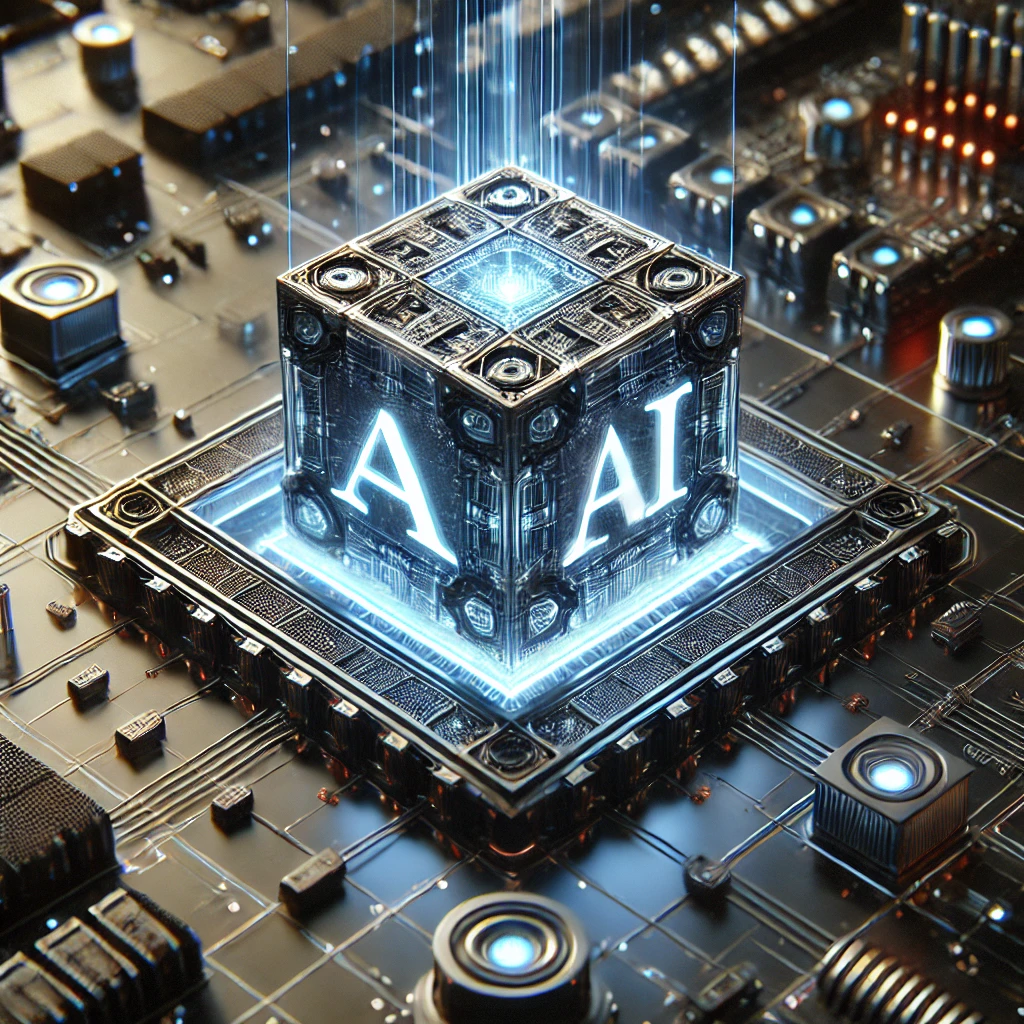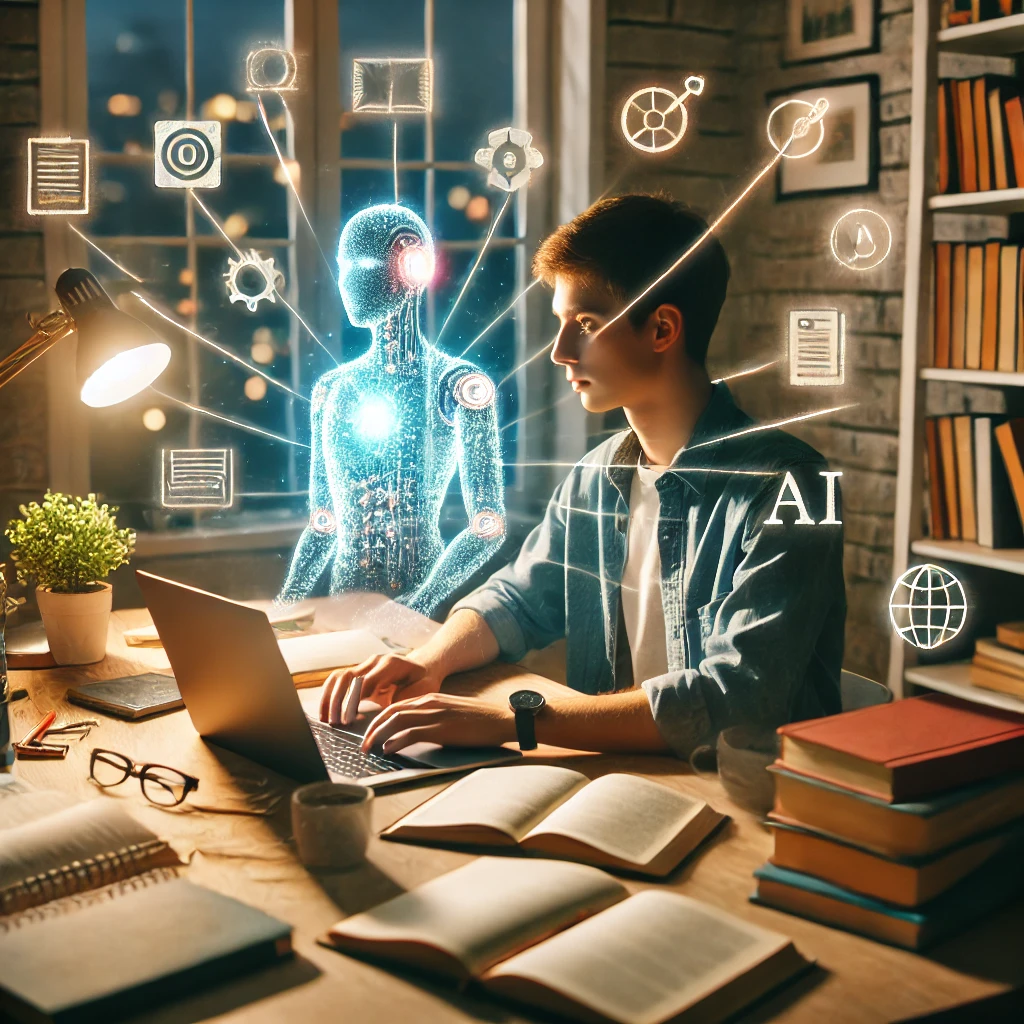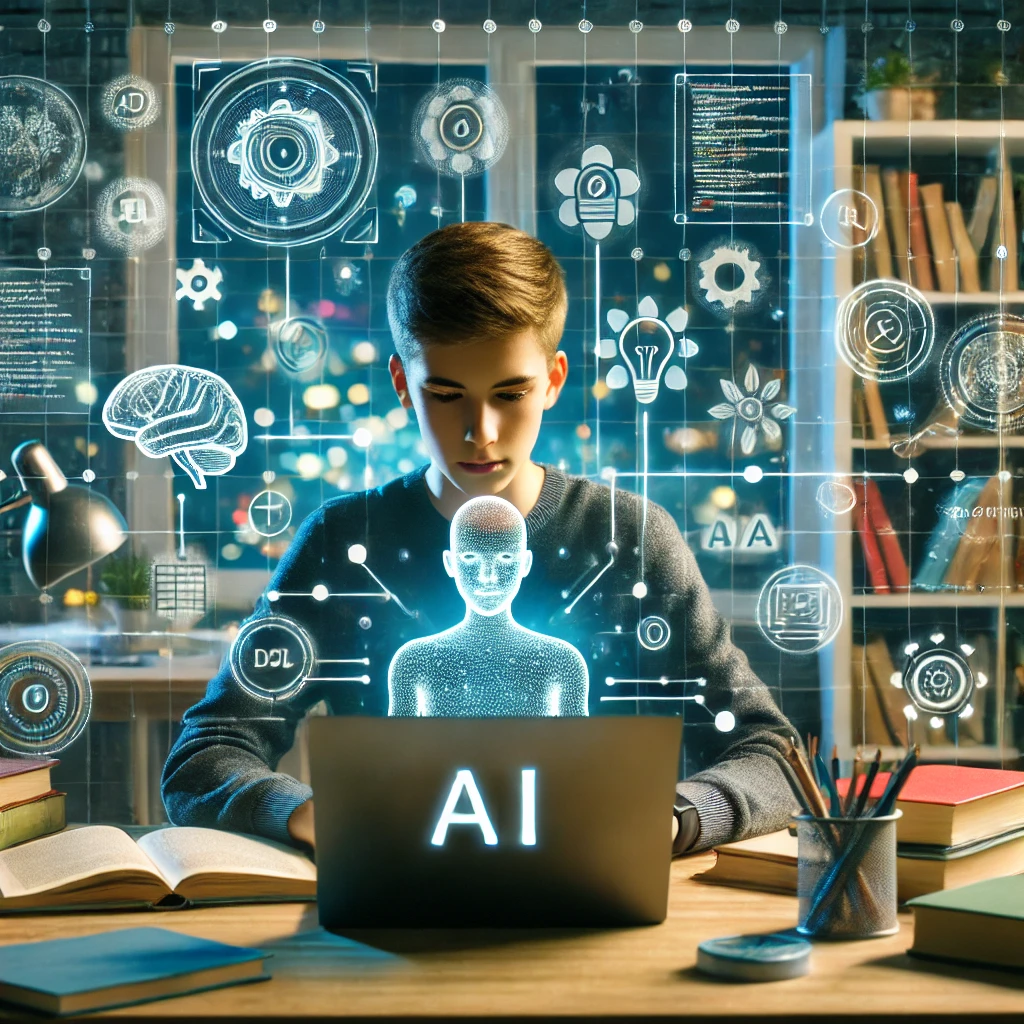1. Introduction
Artificial Intelligence has rapidly evolved from a fictitious concept in science fiction to a transformative force in the real world. AI refers to computer systems designed to perform tasks that typically require human intelligence, such as learning, reasoning, problem-solving, perception, and understanding language. The rapid growth of AI is significant because it is shaping industries, driving innovations, and changing daily life in unprecedented ways.
Understanding AI’s impact on youth is as crucial as ever. As the first generation to grow up entirely in the digital era, including the writer here, today’s youth is inherently connected to technology.
AI’s influence on education and career opportunities for teenagers is profound, opening new ways for learning and future employment.

2. Opportunities of AI for Youth
Advanced technologies are transforming education by providing personalized learning experiences tailored to individual needs. Tools such as adaptive learning platforms analyze a student’s performance in real time and adjust the curriculum accordingly. This personalization addresses individual strengths and weaknesses, making learning more efficient and engaging.
For example, platforms like Khan Academy and Duolingo use algorithms to customize lessons, ensuring that students grasp foundational concepts before progressing. According to UNESCO, adaptive learning technologies can bridge educational gaps by catering to diverse learning styles and paces, ultimately enhancing skill development among youth.

Creative Empowerment
Technology empowers teenagers to express their creativity without requiring advanced technical skills. Tools enable teens to create music, art, and written content through intuitive interfaces. Applications like Amper Music allow users to compose original music by selecting genres and moods, while platforms like DeepArt transform photos into artworks inspired by famous artists.
These innovations democratize creative expression, making it accessible to a broader audience. By lowering barriers to entry, they encourage teens to explore and develop their artistic talents, fostering innovation and self-expression.
Career and Employment Insights
Innovative platforms assist teenagers in identifying future career paths by analyzing job trends and providing personalized skill recommendations. These services aggregate data on emerging industries, in-demand skills, and market projections to guide youth in making informed decisions about their education and professional development.
For instance, such tools can suggest courses, internships, or extracurricular activities that align with a teen’s interests and the evolving job market. The World Bank notes that leveraging technology for career guidance can enhance employment prospects by aligning individual capabilities with market needs.
Mental Health Support
The mental well-being of teenagers can benefit significantly from technology-powered solutions. Chatbots and mental health apps offer real-time support for those experiencing anxiety, depression, or other mental health challenges. Apps like Woebot provide cognitive-behavioral therapy techniques through conversational interfaces, helping users manage their emotions and develop coping strategies.
These tools offer accessible and immediate assistance, which can be especially valuable for teens hesitant to seek traditional therapy. While not a replacement for professional care, technology-driven mental health support serves as a supplementary resource to promote emotional well-being.
Accessibility for Teens with Disabilities
Technologies enhance accessibility for teenagers with disabilities by providing assistive tools that facilitate communication and interaction. Speech recognition software enables users with mobility impairments to control devices using voice commands, while language translation services assist non-native speakers in overcoming language barriers.
For visually impaired teens, applications like screen readers and image recognition software describe visual content aloud. Such innovations promote inclusivity, ensuring that all teens can participate fully in educational and social activities.
By embracing these opportunities, teenagers can leverage technology to enhance their learning experiences, express their creativity, make informed career choices, support their mental health, and overcome accessibility challenges. The impact on youth is profound, offering tools and resources that empower them to navigate and shape their futures in a rapidly changing world.
3. Challenges Faced by Youth Due to AI
3.1 Privacy Concerns
As teenagers increasingly use applications driven by intelligent systems, their personal data is often collected and processed, sometimes without their explicit consent or understanding. This raises significant privacy concerns, as sensitive information can be misused or inadequately protected.
These platforms rely on vast amounts of data to function effectively, often including personal details about users’ habits, preferences, and behaviors. For teens who may not be fully aware of the implications of data sharing, this can lead to unintended exposure of personal information.

Associated Risks:
- Data Misuse: Personal data can be sold to third parties or used for targeted advertising without users’ knowledge.
- Security Breaches: Inadequate data protection can result in hacking and unauthorized access to personal information.
- Lack of Consent: Teens may not fully understand privacy policies, leading to uninformed consent.
For more information on this topic, refer to the UNICEF report on Children’s Online Privacy and Freedom of Expression.
3.2 Misinformation and Manipulation Risks
Content generated by advanced technologies can create or amplify misinformation, which may influence teenagers’ beliefs and actions. Deepfakes and fabricated news can be particularly deceptive, making it difficult for young people to discern truth from falsehood.
Social media platforms use algorithms to curate content, which can inadvertently promote sensational or misleading information to maximize user engagement. This can lead to the spread of conspiracy theories, propaganda, or harmful ideologies among impressionable youth.
Influence on Beliefs:
- Echo Chambers: Algorithms may reinforce existing beliefs by showing similar content, limiting exposure to diverse perspectives.
- Manipulative Content: Technology can tailor persuasive messages that manipulate emotions and opinions.
For further reading, see the UNESCO publication on Combating the Disinfodemic.
3.3 Digital Inequality
Access to advanced technologies is not evenly distributed, potentially widening the gap between tech-savvy youth and those without access. This digital divide can exacerbate existing social and economic inequalities.
Factors Contributing to Digital Inequality:
- Socioeconomic Status: Families with lower income may not afford devices or internet access necessary for these tools.
- Geographical Location: Rural or underserved areas may lack infrastructure for high-speed internet.
- Educational Disparities: Schools in disadvantaged areas may not have the resources to incorporate advanced technologies into curricula.
This inequality means that some teenagers miss out on the benefits of enhanced learning and skill development, putting them at a disadvantage in future job markets.
For more details, refer to UNESCO’s report on Artificial Intelligence in Education: Challenges and Opportunities for Sustainable Development.
3.4 Job Displacement and Automation Anxiety
The rise of automation brings concerns about future employment opportunities for today’s youth. As systems become capable of performing tasks previously done by humans, there’s a fear that this could lead to job displacement.
Impact on Future Job Markets:
- Automation of Entry-Level Jobs: Positions traditionally filled by young people may be automated.
- Skill Requirements: Future jobs may demand advanced technical skills that not all teens have the opportunity to acquire.
- Economic Uncertainty: Worries about long-term career prospects can cause anxiety among youth.
Understanding these trends is crucial for preparing teenagers to adapt to the changing job landscape.
For insights into how automation may affect future employment, see the World Bank’s World Development Report on The Changing Nature of Work.
By addressing these challenges, society can work towards mitigating the negative effects on youth and ensure that all teenagers have the opportunity to benefit from technological advancements.
4. Practical Tips for Teenagers Navigating Technological Impact
4.1 How to Leverage Technology for Learning and Career Development
Advanced technologies offer a wealth of resources that can enhance your education and provide insights into future career paths. Here are some practical ways to make the most of these tools:
- Utilize Advanced Learning Platforms:
- Adaptive Learning: Engage with platforms like Khan Academy and Coursera that personalize your learning experience. These platforms adjust content difficulty based on your performance, helping you focus on areas that need improvement.
- Language Learning: Use apps like Duolingo for language studies, tailoring lessons to your learning pace.
- Explore Online Courses on Technology:
- Use Tools for Career Guidance:
- Career Exploration: Websites like CareerExplorer match your interests and strengths with potential career paths.
- Job Market Insights: Platforms like LinkedIn and Glassdoor provide personalized job recommendations and industry trends.
- Participate in Competitions and Workshops:
- Hands-On Experience: Engage in competitions like those on Kaggle, where you can work on real-world data science challenges.
- Community Learning: Join tech-focused groups or clubs at your school or online to collaborate and learn from peers.
- Leverage Technology for Personal Skill Enhancement:
- Cognitive Training Apps: Use apps like Elevate and Lumosity to improve memory, attention, and problem-solving skills.
- Creative Tools: Explore platforms like Canva for graphic design or Amper Music for music creation to develop your creative talents.
4.2 Staying Safe Online
With the growing presence of advanced technologies, it’s essential to protect yourself from potential risks:
- Protect Personal Data:
- Privacy Settings: Regularly review and adjust privacy settings on social media and other online accounts.
- Strong Passwords: Use complex passwords and consider a reputable password manager. Enable two-factor authentication for added security.
- Mindful Sharing: Be cautious about the personal information you share online.
- Recognize and Avoid Misinformation:
- Verify Sources: Check the credibility of information with trusted news outlets and official organizations.
- Critical Evaluation: Look out for sensational headlines or content designed to mislead.
- Use Fact-Checking Tools: Websites like Snopes and FactCheck.org can help verify doubtful information.
- Identify Deepfakes and Generated Content:
- Awareness: Understand that technology can create realistic but fake images, videos, or audio recordings.
- Signs of Deepfakes: Pay attention to inconsistencies in facial movements, lighting, or audio syncing in videos.
- Stay Informed: Keep up-to-date with the latest trends in digitally generated misinformation.
- Safe Online Practices:
- Phishing Awareness: Be cautious of unsolicited messages asking for personal information.
- Secure Connections: Use trusted networks, especially when sharing sensitive information.
4.3 Ethical Use of Technology Tools
Using advanced tools responsibly ensures that their benefits are maximized while minimizing potential harm:
- Practice Critical Thinking:
- Question Outputs: Remember that systems can make mistakes or exhibit biases. Always evaluate generated information critically.
- Understand Limitations: Recognize that technology operates within the parameters set by its developers.
- Be Mindful of Ethical Implications:
- Respect Privacy: Ensure you have consent when involving others and avoid infringing on privacy.
- Avoid Misuse: Do not use technologies to harm others or violate rights.
- Promote Fairness: Support applications designed to be inclusive and fair.
- Stay Informed and Educated:
- Learn About Ethics: Familiarize yourself with ethical considerations like bias and accountability.
- Engage in Discussions: Participate in conversations about the societal impact of technology.
- Advocate for Responsible Development:
- Support Ethical Companies: Choose products and services committed to ethical practices.
- Voice Concerns: Report unethical use to authorities or platform administrators.
- Contribute Positively:
- Create Responsible Content: Ensure your projects adhere to ethical guidelines.
- Encourage Peers: Motivate others to use tools responsibly.
By leveraging technology for learning and career development, staying safe online, and using tools ethically, teenagers can maximize benefits while mitigating risks. Embracing these practices empowers you to navigate the tech-driven world confidently and responsibly, positioning you for success in an increasingly technological future.
5. Technological Literacy: What Every Teen Should Know

5.1 Basics of Intelligent Systems and Generative Models
What is Artificial Intelligence?
Artificial Intelligence is a branch of computer science focused on creating machines and software capable of performing tasks that typically require human intelligence. These tasks include learning from experience, recognizing patterns, understanding natural language, problem-solving, and decision-making.
How Does It Work?
- Machine Learning (ML): A subset where algorithms learn from data. ML models improve their performance over time as they are exposed to more information.
- Deep Learning: A type of ML that uses neural networks with multiple layers to analyze complex patterns in data.
- Natural Language Processing (NLP): Enables computers to understand, interpret, and generate human language.
What is Generative Modeling?
Generative models refer to systems that can create new content—such as text, images, music, or videos—by learning from existing data. Unlike traditional systems that might classify or predict data, generative models produce original content based on patterns they’ve learned.
Examples of Generative Models:
- ChatGPT: A language model developed by OpenAI that can generate human-like text. It can engage in conversations, answer questions, write essays, and assist with creative writing.
- DALL·E: Another model by OpenAI that creates images from textual descriptions. By inputting a description like “a cat riding a skateboard,” DALL·E can generate a unique image representing that scene.
How Do Generative Models Create Content?
- Training on Large Datasets: These models are trained on vast amounts of data from the internet, including books, articles, images, and more.
- Understanding Patterns: During training, they learn patterns, grammar, context, and relationships within the data.
- Generating New Content: When given a prompt, the model uses what it has learned to generate new content that is coherent and relevant to the input.
Applications of Generative Technology:
- Creative Writing: Assisting in writing stories, poems, and scripts.
- Art and Design: Creating original artwork or design concepts.
- Music Composition: Generating melodies or harmonizing existing music.
- Education: Explaining complex concepts in simple terms or generating practice problems.
5.2 Responsible Use of Technology
As these tools become more prevalent, teenagers need to use them responsibly and ethically. Here are some guidelines to help navigate safely:
- Understand the Limitations:
- Not Perfect: Models can sometimes produce incorrect or nonsensical information. Always cross-check important facts with reliable sources.
- Bias and Fairness: Systems may reflect biases present in their training data. Be aware of potential stereotypes or unfair representations.
- Protect Your Privacy:
- Be Cautious with Personal Information: Avoid sharing sensitive personal details when using online tools, especially on public platforms.
- Read Privacy Policies: Understand how your data is used and stored by the services you use.
- Think Critically About Content:
- Evaluate Outputs: Don’t accept generated content at face value. Analyze and question the information just as you would with any other source.
- Avoid Misinformation: Be vigilant about deepfakes or fake news. Verify information with trusted sources.
- Use Ethically:
- Respect Others: Do not use technology to harass, bully, or spread hate speech.
- Avoid Plagiarism: When using tools for assignments or creative projects, ensure that you contribute your original thoughts and give credit where appropriate.
- Follow Guidelines: Adhere to school policies and ethical guidelines when using these tools for academic work.
- Balance Technology Use:
- Set Healthy Limits: Allocate specific times for using these tools and ensure you have time for offline activities, hobbies, and face-to-face interactions.
- Mindful Engagement: Use technology to enhance your skills and knowledge, not as a replacement for genuine learning and effort.
- Stay Informed and Educated:
- Learn About Technology: Educate yourself on how these systems work, their benefits, and their challenges.
- Keep Up to Date: Stay informed about new developments, updates, and discussions around emerging technologies.
- Encourage Open Communication:
- Discuss with Peers and Adults: Share your experiences and talk about any concerns with friends, parents, or teachers.
- Seek Guidance: If you’re unsure about how to use a tool responsibly, ask a trusted adult for advice.
- Promote Inclusivity and Diversity:
- Support Fair Practices: Encourage the development and use of systems that are inclusive and fair to all users, regardless of background.
- Be Aware of Global Impact: Understand that technologies can affect people differently around the world. Consider the broader implications of their use.
- Report Misuse:
- Speak Up: If you encounter unethical use, such as cyberbullying or spreading harmful content, report it to the appropriate authorities or platform administrators.
- Help Others: Assist friends or peers who may be unaware of responsible practices.
Conclusion
By understanding the basics of these technologies and generative models, teenagers can better appreciate the tools shaping their world. Responsible usage ensures that they serve as positive aids for learning, creativity, and problem-solving. Embracing technological literacy empowers young people to navigate the digital landscape confidently and ethically, preparing them for a future where these advancements continue to play a significant role.
6. Case Studies: Real-World Impacts on Youth
6.1 Examples of Technology in Education
Case Study: Squirrel Learning in China
Squirrel Learning is an adaptive platform that provides personalized education in subjects like mathematics and science. Operating extensively in China, it has transformed the traditional tutoring landscape by offering individualized learning paths for students.
- Impact on Students: During periods of remote learning, such as the COVID-19 pandemic, Squirrel enabled students to continue their education seamlessly from home. The platform assesses each student’s strengths and weaknesses in real time, adjusting the curriculum to focus on areas that need improvement. This personalization has led to increased student engagement and improved academic performance.
- Teacher Support: By automating routine tasks like grading and progress tracking, teachers can focus more on interactive and creative aspects of teaching. Educators receive detailed analytics on student performance, allowing for targeted interventions.
Case Study: Carnegie Learning’s MATHia in the United States
MATHia is a tutoring software developed by Carnegie Learning, designed to enhance math education for middle and high school students.
- Impact on Students: Schools implementing MATHia reported significant gains in student proficiency. The software provides step-by-step guidance and immediate feedback, helping students understand complex mathematical concepts. During remote learning, MATHia offered a consistent educational experience, bridging the gap caused by the absence of in-person instruction.
- Adaptive Learning: MATHia adapts to each student’s problem-solving approach, offering customized exercises that cater to their learning style. This has been particularly beneficial for students who require additional support or advanced challenges.
6.2 Technology in Youth Services and Programs
Case Study: Integration in Youth Employment Programs with Pymetrics
Pymetrics is a platform that uses neuroscience games and algorithms to match job seekers with suitable careers.
- Impact on Youth Employment: Pymetrics has helped young people identify career paths that align with their natural abilities and interests. By assessing cognitive and emotional traits through interactive games, the platform provides personalized career recommendations. This approach has increased job satisfaction and reduced turnover rates among young employees.
- Promoting Diversity: By focusing on individual potential rather than traditional metrics like resumes, Pymetrics reduces biases in the hiring process. This has opened up opportunities for teenagers from diverse backgrounds.
Case Study: Mental Health Support with Woebot
Woebot is a chatbot designed to provide mental health assistance through cognitive-behavioral therapy techniques.
- Impact on Teen Mental Health: Woebot offers accessible, immediate support for teenagers experiencing anxiety, depression, or stress. The chatbot engages users in conversations that help them process emotions and develop coping strategies. Especially during times when in-person counseling is less accessible, Woebot serves as a valuable tool for mental well-being.
- User Engagement: The app’s conversational style and 24/7 availability encourage regular use. Teens report feeling more understood and less stigmatized when discussing their feelings with Woebot.
These case studies illustrate the significant impact of advanced technologies on the lives of teenagers. From enhancing education through personalized learning to supporting mental health and promoting employment opportunities, these tools are playing a pivotal role in shaping the experiences and futures of young people globally. By understanding and leveraging these resources, teenagers can overcome challenges, access new opportunities, and contribute positively to society.
7. Conclusion
Balancing Opportunities and Challenges
Intelligent technologies profoundly affect teenagers, offering exciting opportunities like personalized learning, creative tools, career guidance, and mental health support. Simultaneously, they pose challenges such as privacy concerns, misinformation, digital inequality, and fears about job automation. Understanding both the benefits and risks of these advancements is crucial.
Encouraging Active Engagement
Teenagers are encouraged to actively engage with modern technologies, utilizing their advantages while being aware of potential downsides. By fostering technological literacy, practicing responsible usage, and staying informed, they can harness these tools to shape a positive future for themselves and society.
Additional Resources
Educational Platforms
- Coursera: AI for Everyone – A course that demystifies AI for non-technical people.
- edX: Introduction to Artificial Intelligence – An introductory course on AI concepts.
Books
Organizations
- AI4ALL: An organization dedicated to increasing diversity and inclusion in AI education.
- Code.org: Provides resources for learning computer science and programming.
- Girls Who Code: Aims to close the gender gap in technology and engineering.





